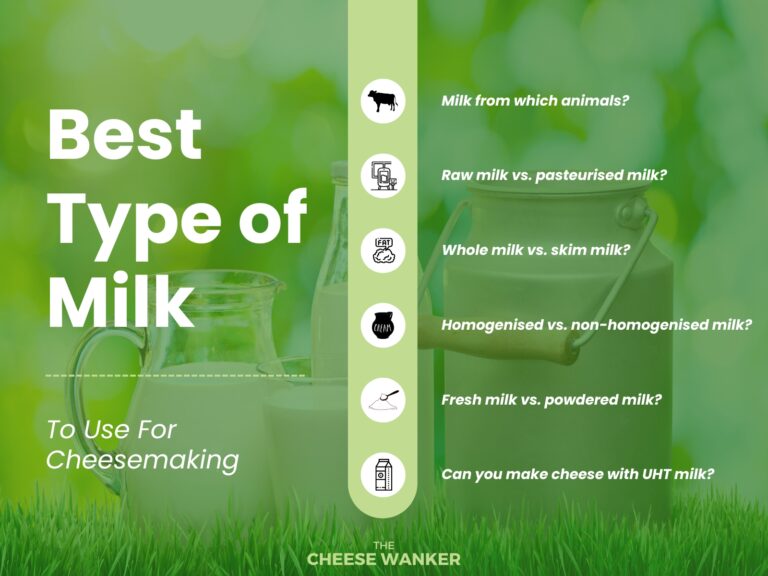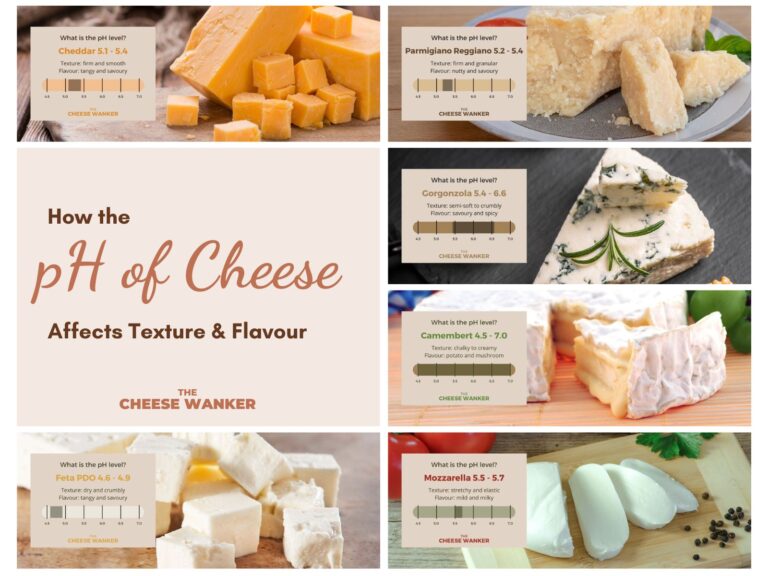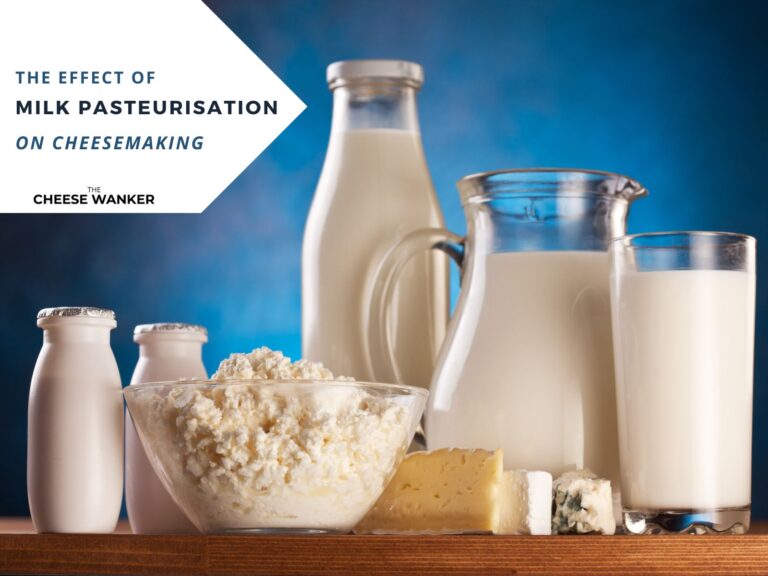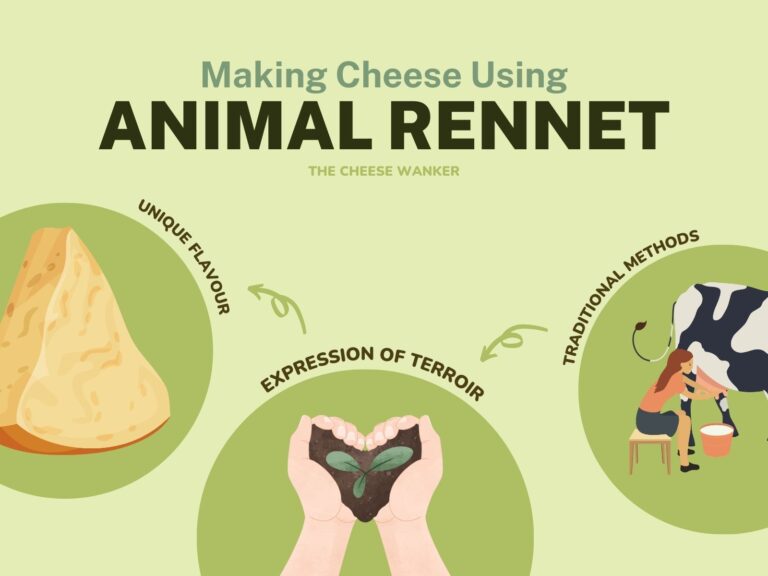Genetically modified (GMO) microbial rennet is a type of enzyme used in the production of cheese. It is produced by transferring the gene responsible for producing chymosin from animal cells into microbial cells. Read on to learn more about this type of rennet and its use in commercial cheesemaking.
SEE ALSO: Our definitive guide to using rennet in cheesemaking →
What is rennet?
Before we go deep in this conversation on GMO rennet, let’s do a quick intro on rennet. Rennet is an enzyme that plays a crucial role in cheesemaking by coagulating milk and separating it into solid curds and liquid whey.
The coagulation process occurs when the rennet enzyme cleaves the proteins in the milk, causing the milk to thicken and form a gel-like substance. Traditionally, cheesemakers used a rennet called chymosin to coagulate their milk.
Different types of rennet
Presently, the rennet used in cheesemaking falls broadly into three categories: animal, plant-based and microbial. In this post, we will be taking a close look at microbial rennet and the two main versions of it.
Microbial rennet is derived from the microbial fermentation of fungal or bacterial cultures. Unlike animal or plant-based rennet, microbial rennet is produced through a controlled fermentation process. Overall, this allows for consistent quality and reliable results.
What does microbial fermentation mean?
Microbial fermentation is a metabolic process in which microorganisms convert carbohydrates into organic acids, gases or alcohols for energy. Typically, this process takes place in the absence of oxygen. As a matter of fact, fermentation is used in the production of various food and beverage products. Some examples are bread, beer, wine, cheese and yoghurt.
What does any of this have to do with rennet? Well, one of the by-products of fermentation by certain microorganisms is an enzyme that is closely related to chymosin. And this particular enzyme can be purified and formulated into a usable rennet form.
Different types of microbial rennet
There are basically two different types of microbial rennet that are used in cheesemaking. And as you will soon find out, one is far more popular than the other.
1. Natural microbial rennet
Moulds such as Rhizomucor miehei can produce proteolytic enzymes, which are then concentrated and purified in a fermenter to eliminate contaminants. The traditional belief was that these coagulants caused bitterness and reduced cheese yield. Actually, this negative impact was most pronounced with matured cheeses such as Cheddar, Gouda and Parmesan.
However, advancements in microbial coagulants have resulted in the production of high-quality cheeses using microbial rennet. Despite this, natural microbial rennet is far less popular than the next one on our list.
2. Fermentation Produced Chymosin (FPC)
Presently, about 90% of commercial cheeses produced in the USA use Fermentation Produced Chymosin. While not all FPC are made using recombinant DNA technology, the most popular ones are. Overall, the main reason for this is that GMO FPC rennet produces the most consistent and highest yield of cheese from milk.
To make GMO rennet, lab scientists isolate the chymosin-producing gene (RNA) in animal rennet and splice it into bacteria or fungi. Consequently, the microorganisms start producing chymosin when they ferment. Different companies use genes from different sources (animal and microbial) and splice them into different bacteria and fungi. We’ll get back to this a bit later.
Is GMO rennet safe?
Actually, the safety of genetically modified rennet is a topic of ongoing scientific and regulatory debate. Some studies suggest that GMO rennet is safe and has similar properties to traditional animal rennet. On the other hand, others raise concerns about potential allergic reactions or other health effects.
It is important to note that the safety and regulatory status of GMO rennet can vary by country. In some countries, it is considered safe and approved for use in food production. While in others, it may be subject to restrictions or banned altogether. Moreover, depending on the local regulations, FPC can be labelled as being GMO-free in some countries.
Ultimately, there is still very limited scientific data to conclusively state whether cheeses made with GMO rennet are safe or unsafe in the long run. If you have concerns about the safety of GMO rennet or any other food ingredient, it is best to consult with a qualified healthcare professional.
Is genetically modified rennet vegetarian?
This is a hotly debated topic amongst vegetarian communities. Indeed, it depends on the type of genetically-modified (GMO) rennet in question. As a matter of fact, the majority of FPC’s are produced from cells that were initially of animal origin. Hence, stricter vegetarians are inclined to avoid those cheeses.
Having said that, there are a handful of FPC rennet brands that are produced without using any cells of animal origin. By and large, vegetarians consider cheeses made using such rennet to be acceptable.
It is important to note that the labelling and classification of rennet as “vegetarian” or “non-vegetarian” can vary by country and may not always accurately reflect the origin or production method of the rennet. So, let’s take a closer look at a few proprietary FPC’s to determine whether they are vegetarian-friendly.
Commercial examples of FPC rennet
1. Chy-Max®
Chy-Max® is a brand of genetically modified (GMO) rennet used in cheese production. It is produced using recombinant DNA technology, which involves transferring the gene responsible for producing the enzyme chymosin from animal cells into microbial cells, such as yeast or fungi.
Presently, Chr. Hansen, the makers of bioengineered FPC Chy-Max®, uses the fungus Aspergillus niger.
Since the genetic material for Chy-Max® originates from animal sources, some strict vegetarians will avoid eating cheeses made using this rennet.
2. Maxiren®
Next, we have Maxiren®, another popular brand of GMO rennet made by culture giant DSM. According to product data sheets, DSM makes its bioengineered FPC, Maxiren®, using the yeast Kluyveromyces lactis. The original gene that they transposed is of calf origin, making this FPC rennet a contentious choice for vegetarians.
3. Marzyme®
Our third FPC rennet, Marzyme®, is manufactured by another major player in the cheesemaking world, Danisco-DuPont. Actually, Marzyme® is a non-animal microbial rennet. According to the company, no animal genes were ever used in the design and production of this GMO rennet.
Indeed, they isolated the gene for the acid proteinase of Rhizomucor miehei and cloned and expressed it in the fungus Aspergillus Oryzae.
As a result, cheeses made using Marzyme® should be vegetarian-friendly. Moreover, a plant-based cheese made using this rennet would even be vegan-friendly.
4. Hannilase®
Our second offering from Chr. Hansen is Hannilase®. This rennet is a mucorpepsin microbial coagulant produced by fermentation using a select strain of the fungus Rhizomucor miehei. It is a good low-cost alternative for organic cheese and for home cheese making where yield and flavour defects are less of an issue. According to the company, they did not use any animal genes in developing this rennet.
5. Fromase®
Finally, we have DSM’s Fromase®. Under this brand name, you will find a range of microbial coagulants from the fungus Rhizomucor miehei, suitable for all cheese types. Moreover, the company makes the bold claim that Fromase® XL BF and XLG are the purest microbial rennet on the marker. And just like Hannilase®, Fromase® is animal-free and suitable for vegetarians.
Which rennet was used to make my cheese?
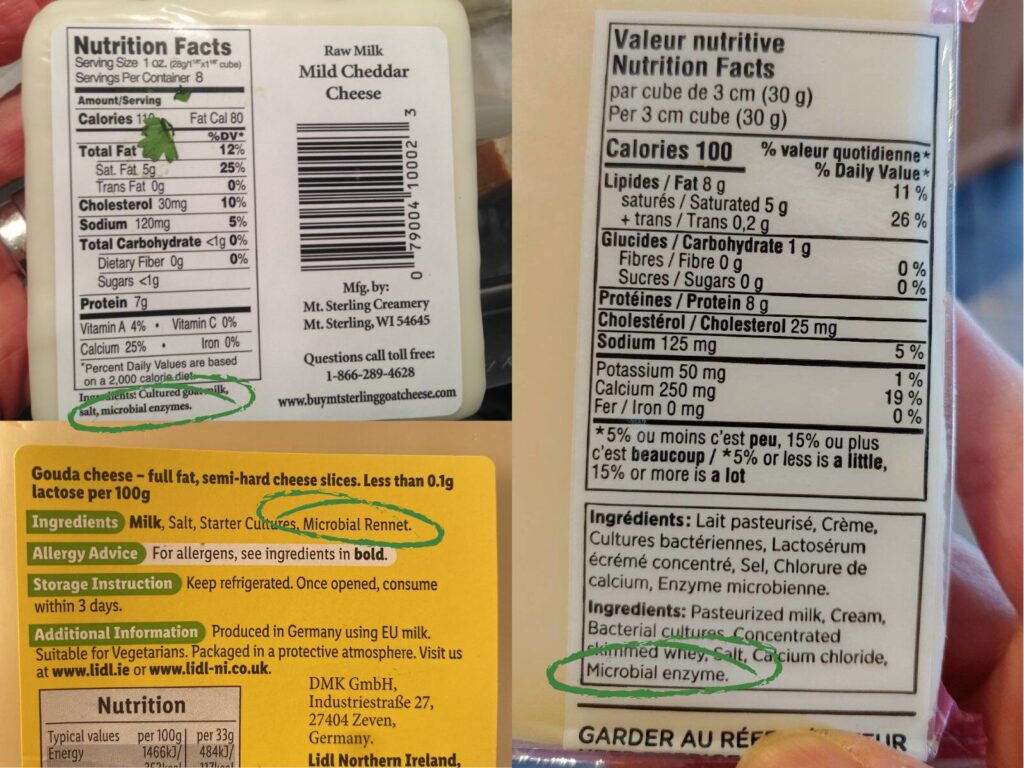
Unfortunately, the FDA does not require that cheesemakers divulge the type of rennet used in their products. As such, you won’t be able to find the answer to this question on the cheese’s label. If you have dietary requirements for ethical or religious reasons, our advice would be to contact the manufacturer to find out what type of rennet they used.
Examples of cheeses made using microbial rennet
Rogue River Blue
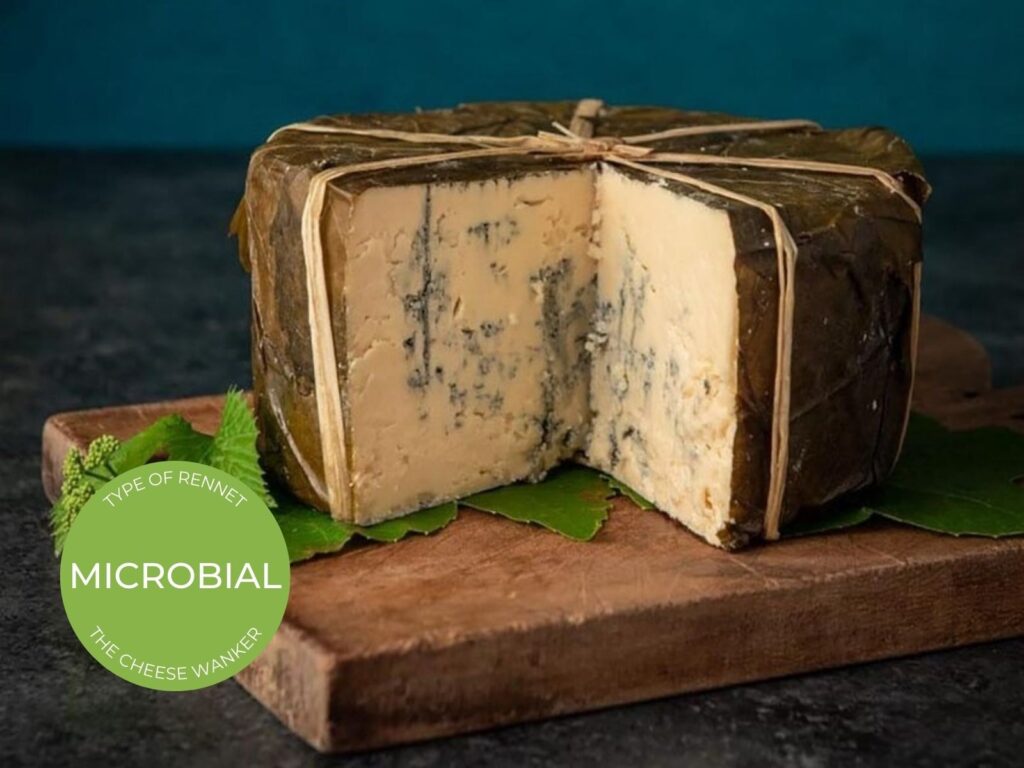
In October 2019, Rogue River Blue became the first American cheese to be named World Champion Cheese at the World Cheese Awards in Italy. This unique blue cheese is seasonally made by Rogue Creamery in Oregon using only their finest milk. Moreover, Rogue River Blue (and all of Rogue Creamery’s other cheeses) is rBST (Recombinant somatotropin), rBGH (Recombinant bovine growth hormone), antibiotic free and gluten free.
Once the curd has been set using microbial rennet, the cheesemaker covers each wheel of cheese in spring-harvested Syrah grape leaves soaked in pear liqueur. Afterwards, an affineur looks after each individual wheel for up to 11 months.
At that age, Rogue River Blue’s texture becomes fudgy and rich and its aroma is reminiscent of pear eau-de-vie. Be prepared for an explosion of flavour ranging from pear brandy to truffle with notes of toffee, blackberry, vanilla, hazelnut, chocolate and bacon.
Whilst this cheese is good enough to eat on its own, you can also enjoy it with a range of beverages. Serve with a dark Belgian Ale or a glass of Scotch Whisky. This blue will also pair beautifully with a Viognier, Gewürztraminer or Sauternes.
Humboldt Fog
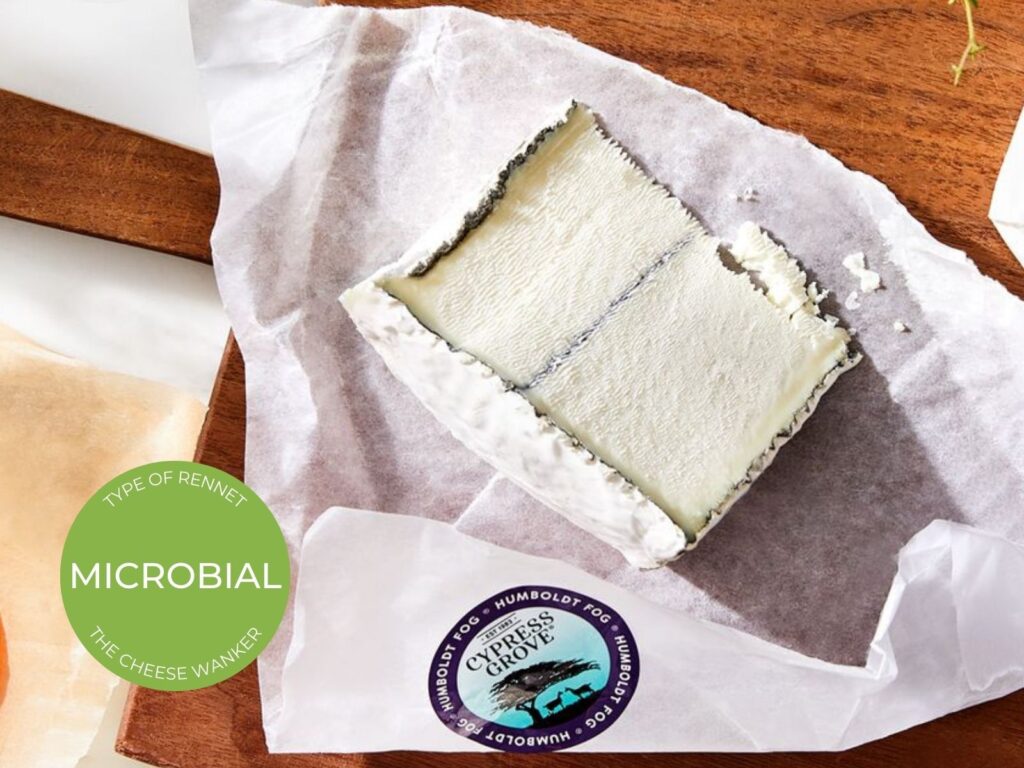
Next, we have the Original American Original®, Humboldt Fog. This soft white mould goat cheese originates from Humboldt County, California. And it gets its name from the morning fog that frequently rolls in from the Pacific Ocean to the Humboldt County coast. Cypress Grove make their signature cheese using the finest local goat milk and microbial rennet.
Over the last decade, its popularity has grown and it is widely regarded as one of the finest examples of American artisanal cheesemaking. Without a doubt, Humboldt Fog is instantly recognisable thanks to its delicate white mould rind, pristine white paste and distinctive layer of ash running through its centre. And it also nails all the flavour notes with a touch of cream and tang!
Humboldt Fog is often served as a table cheese or used in a variety of dishes, including salads, sandwiches, and appetizers. It is also commonly paired with a glass of sparkling wine such as Champagne or Prosecco. But you can also pair it with a light Pinot Noir, a Californian Pilsner or a crisp Cider.
Avonlea Clothbound Cheddar
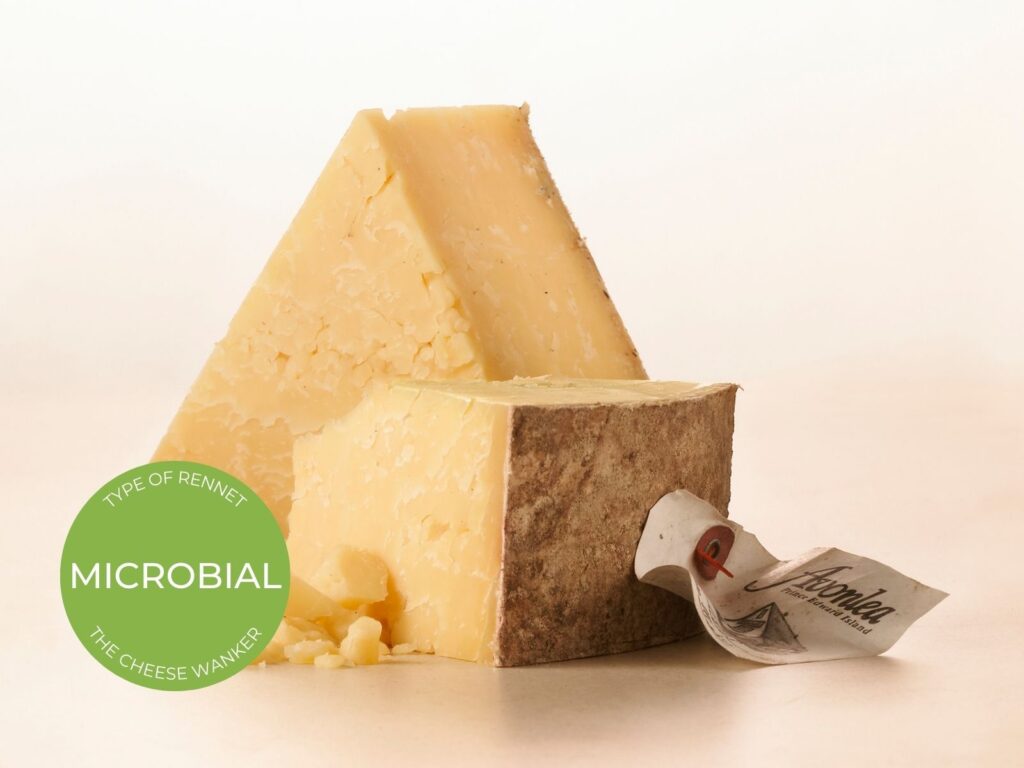
COWS Creamery is located in Charlottetown on Canada’s Prince Edward Island. Creamery owner, Scott Linkletter was inspired to make a Cheddar-style cheese after a visit to the Orkney Islands, north of Scotland. Produced using a Cheddar recipe that Linkletter discovered on that trip and microbial rennet, Avonlea expresses the salt air and iron-rich soils of Prince Edward Island.
With its caramel rind and firm paste, this fudgy Cheddar exhibits a texture that’s amazingly smooth for a clothbound. Moreover, its aromas are mild and minerally with notes of butterscotch and caramel sauce.
Not the least bit bitter, Avonlea’s flavour is sweet and well-rounded with background aromas of tomato and peanut butter. Finally, it leaves an aftertaste that is sweet and milky with notes of brown butter and a tangy bite.
Actually, the warmer this cheese gets, the more savoury it becomes. Hence, you will want to serve Avonlea at room temperature alongside a Pinot Noir or Gewürztraminer, or grate it into a grilled cheese sandwich.
Microbial rennet FAQs
Let’s finish up our guide to microbial rennet with some of your most commonly asked questions.
Where can I buy microbial rennet from?
Just like other forms of rennet, you can buy microbial rennet from online cheesemaking suppliers (e.g., New England Cheesemaking Supply Company and Little Green Cheese).
What are the advantages of using microbial rennet?
Microbial rennet is considered to be more consistent and reliable in its coagulating properties than animal and plant rennet.
How does microbial rennet affect the flavour of cheese?
Actually, the flavour of cheeses made using microbial rennet compare quite favourably with ones made using animal rennet. Thanks to the advances in FPC technology, rennet companies have been able to produce forms of chymosin which very closely mimic the original animal-derived ones.
Conclusion: microbial rennet brings consistency and scale
Thank you for reading our post on microbial rennet. As you can see, it is an area of cheesemaking that has significantly evolved over the last couple of decades. Nowadays, rennet like FPC have become the most popular form in New World cheese markets such as the USA and Australia. And the main reason for that is their consistency and cost.
Have you tried making cheese using microbial rennet? I’d love to hear about your experience. Which rennet did you use? Let me know in the comments below.
